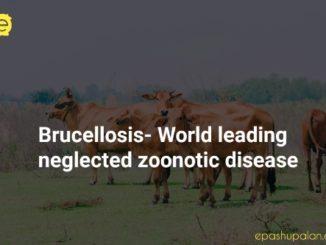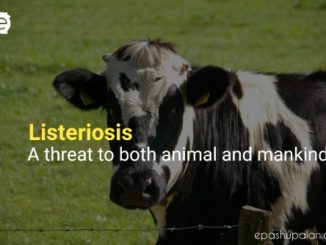The term zoonosis is derived from Greek word Zoon means “animals” and nosos means “sickness”. The World Health Organisation (WHO) defines zoonosis as any disease or infection that is naturally transmissible from vertebrate animals to humans. Zoonoses may be bacterial, viral, or parasitic origin. Being a public health problem, many of the major zoonotic diseases prevent the efficient production of food of animal origin and create obstacles to international trade in animal products.
The poultry sector is the fastest growing economy in India and largest producer of several agricultural commodities. Poultry meat represents almost one-third of meat produced and consumed globally. Poultry meat and egg production have increased considerably worldwide. As with other livestock, poultry also acts as a potential reservoir of many zoonotic infections. With the ever growing expansion of poultry production, marketing and processing chains there is greater involvement of disease transmission through contact with live birds and also through the consumption of contaminated chicken and eggs and its associated products.
Campylobacter and Salmonella infections are among the most important food safety hazards. They account for more than 90 percent of all reported cases of bacteria-related food poisonings worldwide. Most of these cases are related to the consumption of poultry and poultry products.
Salmonellosis
Salmonella is a genus of rod shaped (bacillus) Gram negative bacteria, non-spore-forming, predominantly motile enterobacteria with cell diameters between about 0.7 and 1.5 μm, lengths from 2 to 5 μm. Salmonellosis is one of the most frequent food-borne zoonoses, constituting a worldwide major public health concern. Salmonellae are isolated more often from poultry and poultry products than from any other food animals. Salmonellosis is caused by non-typhoidal Salmonella enterica serotypes (serotypes other than S. Typhi and S. Paratyphi) and is typically characterized by a self-limiting gastroenteritis syndrome (manifested as diarrhoea, fever and abdominal pain), with an incubation period between 4 and 72 h and mortality being rare. Chickens can be infected with numerous different serovars of Salmonella, most of which will cause disease in humans. Some serovars such as S. Pullorum and S. Gallinarum are specific for chickens and will cause disease in chickens but are not infectious for humans. S. Typhimurium and S. Heidelberg can infect chickens without causing any apparent disease and spread to other hosts, including humans causing disease. Problems occur at slaughter when materials from the digestive tract end up contaminating carcasses. Then, inadequate hygiene measures in the home during food preparation will result in transmission to humans and serious disease. There are many others which will effectively colonize the intestinal tract or reproductive tract of chickens and do not cause any untoward effects in the bird, yet be shed into feces or eggs and cause serious human disease.
Salmonella Enteritidis are shed into the eggs and causes disease in humans. Thorough cooking of eggs kills the organism. Human disease problems arise with uncooked egg products in food, for example Caesar salad dressing, or egg nog. Once in the human gastrointestinal tract, Salmonella bacteria have a survival strategy that allows them to persist, enter epithelial cells, and evade host destruction. The organism stimulates a secretory diarrhea and also destroys epithelium, creating ulcers and an effusive diarrhea. The endotoxin on Salmonella results in cytokine activation and can lead to septic shock.
Campylobacteriosis
Campylobacter species are Gram negative rods in gull-winged shapes and spiral forms. They grow as commensals on the intestinal tract and sometimes in the reproductive tract and are distributed geographically. The infection in the intestine causes diarrhea, and in the reproductive tract causes infertility or abortion. The bacterium’s main natural reservoir is poultry. Humans can contract the disease from eating food contaminated with Campylobacter species. Campylobacter is a significant cause of enterocolitis in consumers of undercooked poultry meat. Campylobacter jejuni and Campylobacter coli are the two predominant species causing gastrointestinal infections. Campylobacter jejuni is the most significant and is responsible for intestinal colonization in poultry and food-borne enteritis in humans. Scalding, defeathering and evisceration represent the significant points of cross-contamination during processing. Campylobacteriosis in humans is an economically important food-borne zoonosis of specific concern to consumers of undercooked poultry, beef and pork. In commercial poultry processing, improved washing of carcasses, use of counter-flow mechanical advances in scalding, elimination of immersion chillers, and reduction in manual handling by installation of advanced automated equipment has reduced C jejuni contamination on poultry meat.
Human campylobacteriosis typically develops 1–5 days after exposure and is characterized by watery and sometimes bloody diarrhoea, fever, abdominal cramps and vomiting lasting for approximately 5–7 days. The stages in the chicken meat production and processing chain consist of primary production at rearing farms, transport to slaughter, the slaughter process and subsequent processing of chicken meat products, selling products at the retail level, and handling and consumption of chicken meat products at home and in public places such as restaurants-have a role in the transmission of Campylobacter from farm to fork. Even though cooking will kill the organism but the problem arises with poor food preparation practices and the co-mingling of uncooked poultry meat with food that will be consumed fresh. People contract the usually self-limiting, sporadic gastroenteritis within 2 to 5 days of ingesting the organism and the abdominal cramping, watery to bloody diarrhea, and occasional fever may last anywhere from a day to a week. Death rarely occurs except in immunocompromised individuals. Guillain-Barré, in which an auto-immune response results in paralysis, is thought to occur in roughly 1 out of 1,000 reported Campylobacter infections.
Escherichia coli infections
Escherichia coli or E.coli are Gram negative rods catalase positive, oxidase negative non-spore forming facultative anaerobes. It is a commensal of birds and mammals, including humans, worldwide and the beneficial nonpathogenic strains far outnumber pathogenic ones. It inhabits the intestinal tract of animals and humans and contaminates vegetation, soil and water. Some members of the family constitute part of the normal flora of the intestinal tract while pathogenic organisms can be found in the environment. Colibacillosis is a broad term that refers to any infection or disease caused by the bacteria Escherichia coli. In mammals, colibacillosis is usually a primary intestinal or urinary tract infection. E.coli found in fresh poultry products can be passed to people, leading to bladder infections and other serious conditions. Humans with colibacillosis usually manifest diarrhea which may be, responsible for debilitating symptoms such as gastro-enteritis (diarrhea, vomiting), headaches, and depression, leading sometimes to death. However, most concerning to human health is not the threat of direct infection from poultry sources but the fact that strains of avian pathogenic E. coli share similar serotypes, virulence factors, and genes and plasmids for antibiotic resistance with human strains. There are certain reports, wherein strains with similar virulent and antibiotic resistance factors have been isolated in retail poultry products that cause cystitis and meningitis in people.
Listeriosis
Listeria spp. are small gram-positive rod (0.5–4 µm in diameter and 0.5–2 µm in length), non-spore-forming, facultative anaerobic, catalase-positive, and oxidase-negative organisms. Listeria has tumbling motility at 20–25°C due to peritrichous flagella. L. monocytogenes is the main cause of foodborne listeriosis in humans. The organism have the ability to cause infection in humans when it comes in contact with the infected birds or consumption of contaminated poultry or poultry products that are pre-cooked and ready to eat. Milk and animal/poultry meat are considered as major sources of infection. Poorly cooked meat and contaminated ready-to eat poultry products are responsible for the infections in humans. As Listeria has the capability to grow even at low temperatures, refrigeration does not ensure protection. Thus the food materials should be cooked at high temperatures. The infection may also cause abortion and stillbirth in pregnant woman and also gets transmitted to the neonates.
Transmission of food-borne avian diseases primarily occurs via food-chain by fecal-oral route. Foodborne listeriosis has three main clinical features, namely, meningitis, septicemia, and abortion. In healthy humans it can cause febrile gastroenteritis, but in susceptible persons (children, elderly, immune-compromised and pregnant women) it may lead to septicemia and meningitis. Unhygienic practice is one of the main vehicles of Listeria that can spread the organism into the environment. According to other studies, 8% to 99% of poultry products were contaminated with Listeria spp. Determination of the pathogenic potential of L. monocytogenes is important from food safety and public health perspective. Once introduced into the processing plants, it is able to survive and remain for a long period under adverse conditions. In the food industry, L. monocytogenes is able to form biofilm which can act as a potential source of contamination. L. monocytogenes is a widely distributed organism in nature, with main reservoirs of soil and forage. Moreover, it was isolated from healthy humans and animals or infected domestic and wild animals.
Conclusions
The frequency of disease transmission from birds to humans might be low, but the diseases crossing the species barrier always pose a significant public health risk to the community with the immunocompromised individuals and pregnant woman at risk. Thorough and proper cooking of raw meat should be practiced and the packed and frozen meat products should be further heated. Hygiene during storage, neat and proper maintenance of kitchen are to be followed. Controlling the pH, water activity, use of preservatives restricted shelf lives are some of the ways that will minimized the problem of contamination. The identification of high-risk foods and zoonotic potential of poultry diseases should be made aware. Therefore the farmers, veterinarians, feed industry and all those involved in the sector should come together to counsel and educate the public on the myths and realities regarding the risks of poultry zoonoses.






Be the first to comment